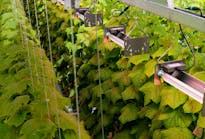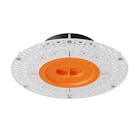Study Finds Large Untapped Potential to Reduce Building Energy Consumption Through Wider Use of Networked Lighting Controls
MEDFORD, MA – September 30, 2020 –The Northwest Energy Efficiency Alliance (NEEA) and the DesignLights Consortium (DLC) yesterday released results of a new study that strengthens the case for expanding use of networked lighting controls (NLC) to significantly drive energy savings in the commercial and industrial sector. The report found that energy savings possible by adding NLCs to LED lighting projects approach 70 percent for some building types, with savings across various categories of buildings averaging 49 percent.
Prepared for the DLC and NEEA by Energy Solutions, “Energy Savings from Networked Lighting Control Systems with and without LLLC” details the results of a one-year study that examined the impact of nearly 200 NLC systems installed in eight different building types. Findings and recommendations will be discussed during a webinar Wednesday, October 15, at 1 p.m. ET.
“It’s already established that networked lighting controls equipped with LLLC capabilities can create truly smart buildings, offering commercial spaces some of the most inherent flexibility and granularity of control on the market,” NEEA Senior Product Manager for commercial lighting Chris Wolgamott said. “This expanded research proves that LLLC also offer some of the most aggressive energy savings across building types utilizing all the controls strategies available, including occupancy, daylighting and high-end trim/task tuning.”
“By digging deeper into the known savings potential of networked lighting systems, this new research enables lighting manufacturers, architects, contractors, utilities, commercial building managers and others to more accurately estimate savings possible by pairing LED lighting projects with NLCs,” DLC Executive Director and CEO Christina Halfpenny said. “It’s another important step on the path to much wider adoption of NLC technology, as a strategy that both drives energy savings and opens a pathway to building intelligence.”
The new research expands upon and confirms the findings of a 2017 study from the DLC and NEEA that also concluded that NLCs have the potential to increase savings beyond those possible with LEDs alone by an average of about 50 percent. “Energy Savings From Networked Lighting Control Systems with and without LLLC” utilized all of the 2017 data, while expanding the project size, increasing representation of and providing a separate analysis for systems with luminaire level lighting control (LLLC) capabilities, and increasing the diversity of building types studied.
The NEEA/DLC research comes as the market for smart, connected lighting is poised to expand. While connected lighting now comprises less than 1 percent of all luminaires in the US, the Department of Energy (DOE) estimates it can provide up to one quad of energy (approximately equal to one-fifth of US commercial sector energy use) by 2035, when just under a third of luminaires in commercial buildings are expected to have network connectivity. Likewise, the saturation of NLC systems with LLLC capability is also on the rise. Limited to lighting in .5 percent and .8 percent of office buildings and warehouses, respectively, in 2016, LLLC capability is forecasted to comprise nearly half of new construction and major renovations in these building types by 2035. With these changes on the horizon, the study results will inform efforts to improve collection, analysis and use of NLC data.
The study released this week looked at NLC savings potential in eight building types: assembly (i.e., auditoriums, theatres, etc.), education, healthcare, manufacturing, office, restaurant, retail, and warehouse. The project collected, aggregated, and analyzed building-, zone-, and fixture-level energy monitoring interval data from NLC systems with and without LLLC capabilities for an average of 13 weeks per building.
Overall average energy savings from all NLC systems was 49 percent, but results were highly site specific – ranging from 28 percent for assembly buildings to 64 and 68 percent, respectively, for office buildings and warehouses. The study also found variations in energy savings in sites implementing aggressive strategies, such as high-end trim and other LLLC capabilities, to achieve deep savings versus those that solely use the basic capabilities of NLC systems.
In addition to calling for further study, the report’s recommendations include proposing that utility efficiency programs for commercial and industrial customers use 49 percent as the best estimate of average portfolio-level energy savings for NLC programs, and standardize the NLC energy data reporting format and requirements to facilitate program participation and streamline the process. Report authors also recommended specifically exploring programs that could yield more robust savings estimates for NLCs with LLLC at the portfolio level and for each building type.
For a full overview of all recommendations and findings, register for the Oct. 15 webinar: https://register.gotowebinar.com/register/2236744610613874959.
About DesignLights Consortium:
The DesignLights Consortium® (DLC) is a non-profit organization whose mission is to achieve energy optimization by enabling controllability with a focus on quality, people, and the environment. The DLC promotes high-quality, energy-efficient lighting products in collaboration with utilities and energy efficiency program members, manufacturers, lighting designers, and federal, state, and local entities. Through these partnerships, the DLC establishes product quality specifications, facilitates thought leadership, and provides information, education, tools and technical expertise.
www.designlights.org
About the Northwest Energy Efficiency Alliance (NEEA):
The Northwest Energy Efficiency Alliance (NEEA) is an alliance of more than 140 utilities and energy efficiency organizations working on behalf of more than 13 million energy consumers. NEEA is dedicated to accelerating both electric and natural gas energy efficiency, leveraging its regional partnerships to advance the adoption of energy-efficient products, services and practices.
Since 1997, NEEA and its partners have saved enough energy to power more than 900,000 homes each year. As the second-largest resource in the Northwest, energy efficiency can offset most of our new demand for energy, saving money and keeping the Northwest a healthy and vibrant place to live.
www.neea.org
Contact:
DesignLights Consortium





